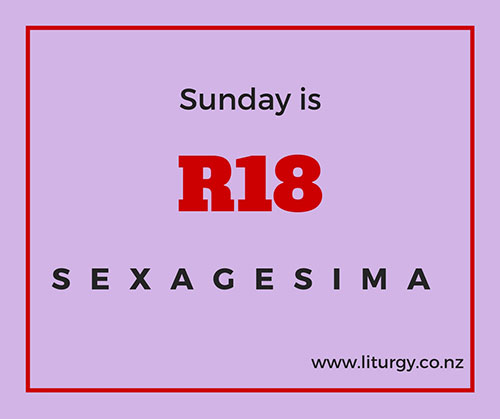
From the Gelasian Sacramentary (7th Century) until the calendar reforms of Vatican II, the ninth Sunday before Easter was called “Septuagesima”, and the eighth Sunday before Easter (this year, this coming Sunday, 12 February 2023) was called “Sexagesima”. The third Sunday in this sequence, the last Sunday before Ash Wednesday (starting Lent), was Quinquagesima.
Sexagesima was a term already used in the Fourth Council of Orleans in 541. The Ordo Romanus, Alcuin, and others count the Sexagesima (60 days) from this day to Wednesday after Easter.
It interests me that, prior to the Vatican II reforms, from Septuagesima right through up to (but not including) the Last Sunday after Pentecost (the Sunday next before Advent) – that whole block of at least 40 Sundays in the church year (I think I’ve got that right!) were linked and moved with the date of Easter. And underneath and behind this block of at least 40 Sundays with their set collect, introit, readings etc. were, hence, possible links back to the Jewish calendar.
Traditionalist Catholics, the Ordinariate, and Lutherans continue this sequence.
Ordinary Time
Since Vatican II, the Church Year was re-designed. Now, rather than moving with Easter, Sundays in Ordinary Time stay close to a date in the Solar Year. For example, this coming Sunday, Ordinary 6, is always between 11-17 February.
There is nothing “ordinary” about “Ordinary Time”. Ordinary Time is not about common, regular, mundane, or run of the mill. Ordinary Time comes from the word “ordinal” as in “ordinal numbers”. Remember your Maths: Cardinal numbers answer “how many?” “Ordinal Numbers” tell the rank, they answer “what position?” Ordinal Numbers are first, second, third, fourth, etc.
There are normally fifty-two weeks in a year. These are made up of the Advent, Christmas, Lent, and Easter Seasons. Normally that leaves thirty-three weeks of “Ordinary Time” (there are 34 for those years with 53 Sundays – in normal years, a Sunday is dropped out in the Lent/Easter Seasons period). Those weeks start from The Baptism of the Lord up to Lent, and start again at the Day of Pentecost.
If you are interested, read more about Ordinary Time here.
New Zealand’s Anglican Lectionary booklet jumps from the “4th Sunday of the Epiphany” to the next week being the “5th Sunday in Ordinary Time” – with no explanation of why it starts on the 5th Sunday and not the 1st Sunday in Ordinary Time.
Ordinary 6
Resources beyond this site:
Textweek
Preaching Resources Down Under
Girardian Reflection on the Lectionary
A Collect Suggested in NZ
God of Israel old and new,
write in our hearts the lesson of your law;
prepare our minds to receive the gospel
made visible in your Son Jesus Christ our Saviour.
Amen.
This is a collect for Sunday suggested in the NZ Anglican lectionary booklet (and in the 2020-published book called “A New Zealand Prayer Book” – in the section of that book called Season after Pentecost – even though there is no such “Season” in contemporary NZ Anglicanism, and furthermore, this Ordinary Sunday always falls prior to the Day of Pentecost.)
Can someone please explain to me what we are being asked to pray for when we pray “God of Israel old and new”?!
Option 1: “old and new” describes/modifies “Israel” – so, we are being asked to pray about the “old Israel” and the “new Israel”. I’m struggling to work out what these two Israels are: the Israel at the time of the Bible, and the State of Israel after 1948? And the prayer says God is god of both? This is rather surprising in a Prayer Book where the Psalter and some canticles systematically removed the words “Israel” and “Zion” where they could be understood as supporting the post-1948 State of Israel! [One of the biggest controversies around the NZ Prayer Book].
Option 2: “old and new” describes/modifies “God” – so this affirms a sort of Process Theology where God is changing.
In either case, I don’t think everyone in the gathered community can give their “Amen” [or worse, as so many NZ Anglican communities do – everyone says the collect together. In some communities, of course, people do not get a chance to see what they are affirming – the next slide comes up on the screen and you are required to just do what it says].
In NZ Anglicanism, the Anglican Church of Or, the collect is optional at the eucharist: you can use a given collect, some use any number of collects, the presider can proclaim it (or any other person can do so) and the community can say “Amen”, or all say the collect(s) together; you can draw the collect(s) from any source; you can make up a collect (including on the spur of the moment); you can address the collect to God, Jesus, any member of the Trinity, the Blessed Virgin Mary, or any Saint – or have it as a wish, not addressed to anyone; or you can omit the collect(s) altogether. So don’t regard the collect in the NZ lectionary booklet (and “2020NZPB”) as having any binding effect (other than it being a formulary which we are bound to believe!)
Do follow:
The Liturgy Facebook Page
The Liturgy Twitter Profile
The Liturgy Instagram
and/or sign up to a not-too-often email


